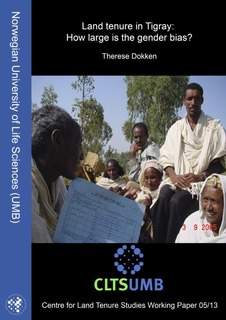| dc.contributor.author | Dokken, Therese | |
| dc.coverage.spatial | Ethiopia, Tigray | nb_NO |
| dc.date.accessioned | 2018-01-22T12:57:00Z | |
| dc.date.available | 2018-01-22T12:57:00Z | |
| dc.date.issued | 2013 | |
| dc.identifier.uri | http://hdl.handle.net/11250/2478741 | |
| dc.description.abstract | This study finds that female-headed households have 23% smaller owned landholdings and 54% smaller operational landholdings. Differences in characteristics such as age, labor, oxen and previous divorce explain less than half the differences in landholding sizes, while the remaining can be attributed to differences in returns to these characteristics. This indicates that there is a gender bias in access to land, even after land reforms that intended to strengthen women’s rights. The main policy recommendation is to further gender-sensitize the land certification process, strengthen women’s opportunities to cultivate their land and continue the process of securing women’s tenure rights. | nb_NO |
| dc.description.sponsorship | NORAD | nb_NO |
| dc.language.iso | eng | nb_NO |
| dc.publisher | Norwegian University of Life Sciences, Ås | nb_NO |
| dc.relation.ispartofseries | CLTS Working paper;2013:5 | |
| dc.rights | Attribution-NonCommercial-NoDerivatives 4.0 Internasjonal | * |
| dc.rights.uri | http://creativecommons.org/licenses/by-nc-nd/4.0/deed.no | * |
| dc.title | Land tenure in Tigray : how large is the gender bias? | nb_NO |
| dc.type | Working paper | nb_NO |
| dc.subject.keyword | Property rights | |
| dc.subject.keyword | Discrimination | |

